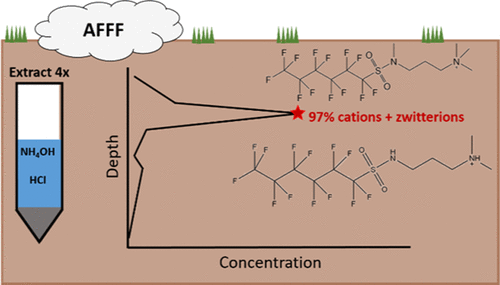当前位置:
X-MOL 学术
›
Environ. Sci. Technol.
›
论文详情
Our official English website, www.x-mol.net, welcomes your
feedback! (Note: you will need to create a separate account there.)
Enhanced Extraction of AFFF-Associated PFASs from Source Zone Soils.
Environmental Science & Technology ( IF 10.8 ) Pub Date : 2020-04-03 , DOI: 10.1021/acs.est.0c00792 Anastasia Nickerson 1 , Andrew C Maizel 1 , Poonam R Kulkarni 2 , David T Adamson 2 , John J Kornuc 3 , Christopher P Higgins 1
Environmental Science & Technology ( IF 10.8 ) Pub Date : 2020-04-03 , DOI: 10.1021/acs.est.0c00792 Anastasia Nickerson 1 , Andrew C Maizel 1 , Poonam R Kulkarni 2 , David T Adamson 2 , John J Kornuc 3 , Christopher P Higgins 1
Affiliation

|
Poly- and perfluoroalkyl substances (PFASs) derived from aqueous film-forming foam (AFFF) are increasingly recognized as groundwater contaminants, though the composition and distribution of AFFF-derived PFASs associated with soils and subsurface sediments remain largely unknown. This is particularly true for zwitterionic and cationic PFASs, which may be incompletely extracted from subsurface solids by analytical methods developed for anionic PFASs. Therefore, a method involving sequential basic and acidic methanol extractions was developed and evaluated for recovery of anionic, cationic, and zwitterionic PFASs from field-collected, AFFF-impacted soils. The method was validated by spike-recovery experiments with equilibrated soil-water-AFFF and analytical standards. To determine the relative importance of PFASs lacking commercially available analytical standards, their concentrations were estimated by a novel semiquantitation approach. Total PFAS concentrations determined by semiquantitation were compared with concentrations determined by the total oxidizable precursor assay. Finally, the described method was applied to two soil cores from former fire-training areas in which cations and zwitterions were found to contribute up to 97% of the total PFAS mass. This result demonstrates the need for extraction and analysis methods, such as the ones presented here, that are capable of quantifying cationic and zwitterionic PFASs in AFFF-impacted source zone soils.
中文翻译:

从源区土壤中增强提取与AFFF相关的PFAS。
尽管从土壤和地下沉积物中衍生出的AFFF衍生的PFAS的成分和分布仍然未知,但衍生自水性成膜泡沫(AFFF)的多氟烷基和全氟烷基物质(PFAS)越来越被认为是地下水污染物。两性离子和阳离子PFAS尤其如此,通过为阴离子PFAS开发的分析方法可能从地下固体中不完全提取两性离子和阳离子PFAS。因此,开发了一种方法,该方法涉及依次进行碱性和酸性甲醇萃取,并评估了从田间采集的,受AFFF影响的土壤中回收阴离子,阳离子和两性离子PFAS的方法。该方法通过平衡土壤水-AFFF和分析标准品的加标回收实验进行了验证。为了确定缺乏市售分析标准的PFAS的相对重要性,可通过新型半定量方法估算其浓度。将通过半定量测定的总PFAS浓度与通过总可氧化前体测定法测定的浓度进行比较。最后,所描述的方法被应用于来自以前的火场训练区的两个土壤核心,其中发现阳离子和两性离子占PFAS总质量的97%。该结果表明需要提取和分析方法(例如此处介绍的方法),这些方法能够对受AFFF影响的源区土壤中的阳离子和两性离子PFAS进行定量。将通过半定量测定的总PFAS浓度与通过总可氧化前体测定法测定的浓度进行比较。最后,所描述的方法被应用于来自以前的火场训练区的两个土壤核心,其中发现阳离子和两性离子占PFAS总质量的97%。该结果表明需要提取和分析方法(例如此处介绍的方法),这些方法能够对受AFFF影响的源区土壤中的阳离子和两性离子PFAS进行定量。将通过半定量测定的总PFAS浓度与通过总可氧化前体测定法测定的浓度进行比较。最后,所描述的方法被应用于来自以前的火场训练区的两个土壤核心,其中发现阳离子和两性离子占PFAS总质量的97%。该结果表明需要提取和分析方法(例如此处介绍的方法),这些方法能够量化受AFFF影响的源区土壤中的阳离子和两性离子PFAS。
更新日期:2020-04-23
中文翻译:

从源区土壤中增强提取与AFFF相关的PFAS。
尽管从土壤和地下沉积物中衍生出的AFFF衍生的PFAS的成分和分布仍然未知,但衍生自水性成膜泡沫(AFFF)的多氟烷基和全氟烷基物质(PFAS)越来越被认为是地下水污染物。两性离子和阳离子PFAS尤其如此,通过为阴离子PFAS开发的分析方法可能从地下固体中不完全提取两性离子和阳离子PFAS。因此,开发了一种方法,该方法涉及依次进行碱性和酸性甲醇萃取,并评估了从田间采集的,受AFFF影响的土壤中回收阴离子,阳离子和两性离子PFAS的方法。该方法通过平衡土壤水-AFFF和分析标准品的加标回收实验进行了验证。为了确定缺乏市售分析标准的PFAS的相对重要性,可通过新型半定量方法估算其浓度。将通过半定量测定的总PFAS浓度与通过总可氧化前体测定法测定的浓度进行比较。最后,所描述的方法被应用于来自以前的火场训练区的两个土壤核心,其中发现阳离子和两性离子占PFAS总质量的97%。该结果表明需要提取和分析方法(例如此处介绍的方法),这些方法能够对受AFFF影响的源区土壤中的阳离子和两性离子PFAS进行定量。将通过半定量测定的总PFAS浓度与通过总可氧化前体测定法测定的浓度进行比较。最后,所描述的方法被应用于来自以前的火场训练区的两个土壤核心,其中发现阳离子和两性离子占PFAS总质量的97%。该结果表明需要提取和分析方法(例如此处介绍的方法),这些方法能够对受AFFF影响的源区土壤中的阳离子和两性离子PFAS进行定量。将通过半定量测定的总PFAS浓度与通过总可氧化前体测定法测定的浓度进行比较。最后,所描述的方法被应用于来自以前的火场训练区的两个土壤核心,其中发现阳离子和两性离子占PFAS总质量的97%。该结果表明需要提取和分析方法(例如此处介绍的方法),这些方法能够量化受AFFF影响的源区土壤中的阳离子和两性离子PFAS。










































 京公网安备 11010802027423号
京公网安备 11010802027423号